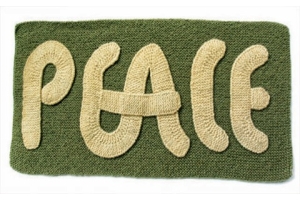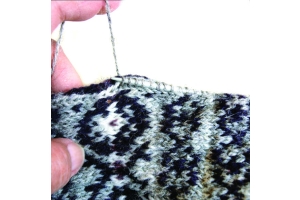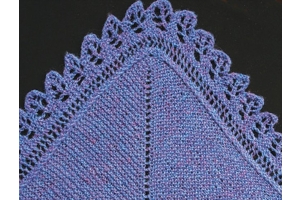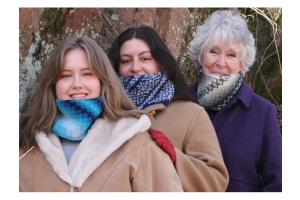Blog #32 Meg Swansen on Fair Isle
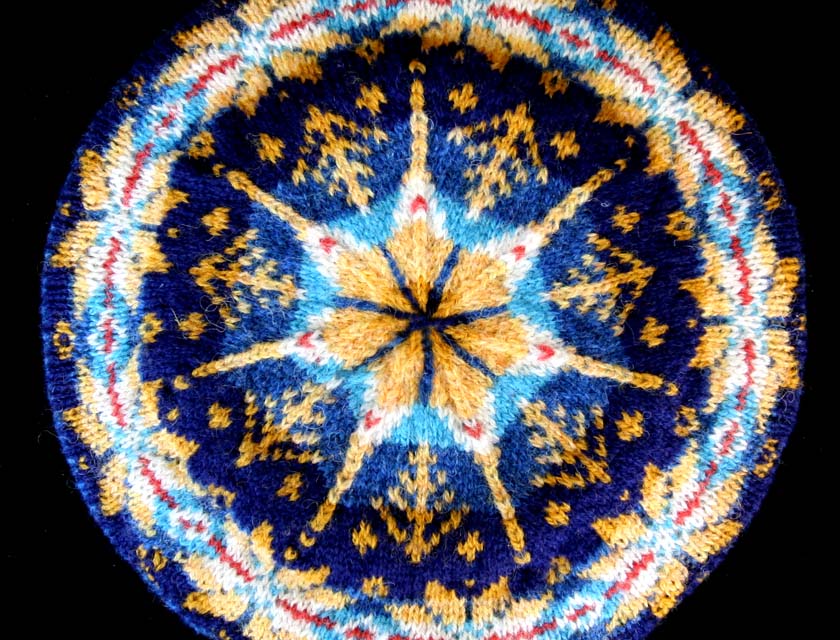
This and That About Fair Isle Knitting
Fair Isle is a specific and satisfying kind of color-pattern knitting, and can be differentiated from all other types. It is unique to that series of small islands, alone in the North Sea. There are only two main tenets (naturally, they are flexible): no color-carry greater than 5, or sometimes 7 sts (gauge dependent), and no more than two colors carried at a time.
One of my soap-box speeches is about the utter uniqueness of Fair Isle knitting, and I want to prevent it from becoming absorbed into the general pool of all other color-knitting patterns.
You may have seen some spectacular garments that you feel sure have more than two colors in a round, but the eye easily can be fooled by switching colors frequently: either the background shades, or the motif colors - and often both at the same time! It is quite riveting to execute these techniques.
A typical motif is an OXO pattern, and there are countless variations from which to choose (see Sheila MacGregor’s wonderful book). Nearly all OXOs (and most other Fair Isle designs) are an uneven number of rounds high, which provides the opportunity to add an unexpected color on the center 1 or 3 rounds. This can produce a vital spark to the color pattern.
An excellent way to practice this intriguing color-pattern work, or to test swatch some colors, is to knit a small Tam, or Tammy. An excellent source for Tam patterns is Mary Rowe’s book: Knitting Tams; Charted Fair Isle Designs.
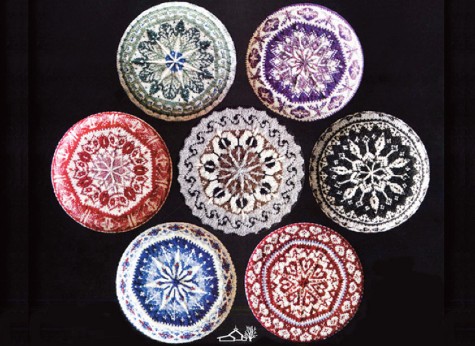
Please - for authenticity - use real Shetland ‘Jumperweight’ wool which knits up beautifully @ between 6.5 to 8 sts per inch. Jamieson’s Shetland Spindrift wool has over 200 colors from which to choose - or simply follow the lovely combinations Mary Rowe has already selected.
For some tips on executing the 2-color technique, see my Blog Number 6, where I write about how I developed my current technique, plus an accompanying video. There are many different ways to hold two colors being knitted alternately, and eventually you will develop your own method - one that is both comfortable, and provides the results you want.
I correspond with knitters daily to answer all kinds of knitting questions. Below are some questions I've received and my answers on Fair Isle and color-pattern knitting, which may offer you some insight.
Good knitting,
Meg
Fair Isle Question and Answer
Question 1:
Hello,
I ventured into knitting the fair Isle vest that Cully modeled but I am about to give up. Take a look at the mess of the yarn ends. How do I deal with changing yarn? To date, I cut the yarn and start the new color. What can be done?
I will likely abandon this but thought to write and ask you the correct way to do it.
Take good care.
Best regards,
Carmen
Answer 1:
Dear Carmen,
I’m so glad you wrote to us so near the beginning of this project. Please do Not Give Up!
You need NOT break off the wool if that color will be used again a few rounds later. I usually place the color inside the circular needle, to keep it out of the way of the other colors, until it will be needed again.
If you will not need that color again for many rounds (more than 1/2 - 3/4 of an inch), then break it, leaving about a 4” tail.
When ending one color, you usually will be adding a new color…
Splice the new color to the 4” tail of the old color, as follows:
Untwist about 3” of the 4” tail, and break off one of the plies.
Do the same thing with about 3” of the new color.
Overlap the two strands in your palm.
Lick your other palm, and rub your hands together briskly - until you feel heat.
That will fuse the fibers together and because you removed half the strand from each end, there will be no noticeable added thickness.
Before knitting the spliced wool, I twist it numerous times to assure it will not come undone.
This vest is a pullover, so the beginning of your round is at one of the side “seams”.
When I know I will be splicing one color to another, I work the splice a few stitches before the actual side stitch; finish the old round, and work the first few sts of the new round with the spliced wools.
If the old color is black, and the new color is white (or some equally contrasting shades), I do not want to knit with such an obvious barber-pole - so will break the old wool, leaving a long tail of both old and new colors, and darn in those ends later.
BUT if the colors are fairly related, you can knit the whole sweater and have only the Cast On and the Cast Off tails to darn it; everything else is spliced.
For further reference, I wrote on this subject for Vogue Knitting (Winter 13/14) - complete with photographs.
I hope this helps… Knit On! Meg
Question 2:
I’ve never made a steek before - too scared. Want to do some fair isle in the round for which I will need steeks. Is there a video or part of a book you could recommend for clear crochet steeking tutorial? I’ve read Meg’s Two Color Knitting and it seem to suggest that only three rows of knitting are used to make a steek, but other sources refer to seven or more steek stitches. I am confused.
Mary
Answer 2:
Dear Mary,
Yes, only the center 3 sts are involved with my method of steeking - but I always have either 5 or 7 total steek sts. The side sts form a facing.
In the book Knitting with Two Colors, please look at the photos on pp 15, 30, 31, and 42 where you can see the full 7-stitch steek. And a “wrapped steek” is shown on p18.
I have done a number of videos which show machine-stitched, crocheted, and needle-felted methods of securing the sts prior to cutting. Several of them are free in my Blog series, specifically Blog #10 and Blog #22.
The videos, Cardigan Details, Fair Isle Vest, and Mimbres Vest show the machine-stitched method.
To build confidence, I suggest knitting a small circular swatch on which you can practice securing and cutting (w/o worry about a failure ruining your newly completed project).
Question 3:
Good morning to you!
I'm knitting along on the Fair Isle Surprise vest and have found my row gauge has turned out slightly larger....instead of starting over on row 4 could I rip back to row 4 from the auxiliary cast on? I am knitting a size 39" vest and am on row 27 with a measurement of about 3.75. I haven't gotten too far, but far enough to know I am pleased with the colors I chose! Thanks for your help!
Fondly,
Julie
Answer 3:
Dear Julie,
You can only rip down from the direction you are now knitting.
Knitted fabric will not rip up from a cast on.
Since you are knitting a diagonal motif, I would trust the fabric to square up a bit when you finally block it.
To reasssure yourself, why not run a thread through a section of the raw sts so you can get some of the knitting flat enough to steam-block.
While it is still hot and damp, yank it width-wise and see if the row-gauge shrinks up a bit.
You needn't expect a perfect square of sts to rounds, but at least square-ish…
Fingers crossed.
Question 4:
Hello
I am learning Fair Isle knitting and am becoming aware of nuances in techniques that can make the difference between a "nice knitting" look and excellent technique. Can you please point me in the right direction for a book that will help me make my Fair Isle knitting soar?
I have Alice Stanmore's Fair Isle book which is some help, and her Tudor Roses (which is for future projects), but hope you can suggest something that might fit the bill on technique in particular.
Many thanks.
Kirsty
Answer 4:
Dear Kirsty,
This may sound a bit self-serving, but I wrote a book - with Amy Detjen and Cully Swansen - on this very subject:
Knitting with Two-Colors contains nearly everything I know about this; my favorite kind of knitting.
I hope it may be of some use to you.
Good Knitting,
Meg
p.s. I should add that there are no garment-patterns in the book; just plenty of techniques.
Question 5:
Hello,
I'm knitting along happily on the Fair Isle Surprise Vest but I find myself wondering if my increase stitches are a little on the tight side. I have been picking up and knitting the bar and the resulting stitch is quite small. What kind of increase did you folks use?
Sincerely,
Julie
Answer 5:
Dear Julie,
I knitted the version shown in the pattern, and also used the bar-increase each side of the marked stitch.
Yes, it is a bit tight (especially when two of them are worked so closely together…borrowing wool from their adjacent stitches), but I would rather have that than a gap/hole which might result from using the working wool to M(ake)1.
If your version is distorting the actual knitting, you might pull the loop of wool a bit further through the twisted-bar-strand.
That should make a slightly larger stitch.
Please let me know how you fare.
Question 6:
Hello,
I am interested in starting a simple teaching project for Fair Isle patterns.
A friend suggested I contact you for suggestions. I have done one Norwegian
pattern and have a variety of needles etc.
Perhaps you could suggest a beginners pattern, and I can look it over and then
phone you for pattern, needle sizes and appropriate yarn to complete the item.
Any suggestions will be appreciated.
Marsha
Answer 6:
Thank you for your enquiry, dear Marsha.
A good introduction to working Fair Isle knitting is probably a smaller project, like a hat or mitts. I suggest SPP#74, which has a simple set of Fingerless Fair Isle Mitts I designed, or try one of Mary Rowe’s tams from her book Knitting Tams; Charted Fair Isle Designs.
Besides the traditional OXO motif which is most often an example of a Fair Isle pattern, it is the use of color that separates Fair Isle knitting from types of color-patterns.
If I may quote myself (from my book, Knitting With Two Colors):
Fair Isle Knitting is our favorite kind of color-pattern knitting. Many knitters refer to any type of color- pattern as “Fair Isle”. However, true Fair Isle is a specific style of two-color knitting that originated in the Shetland Islands. It is defined by an overall design of horizontal or vertical bands of varying widths using geometric shapes. Some of the unique properties of true Fair Isle knitting are:
• both the foreground and background colors may be shaded through a motif.
• each round uses no more than two colors at a time.
• garments are worked in the round, and openings are cut where needed through use of "steeks".
The most common Fair Isle motifs are bands of “OXOs”; lozenges separated by Xs. Narrower bands, between 3 to 9 rounds high, called Peeries, separate the wider OXO bands.
If you are working a geometric Fair Isle chart, there is a soothing rhythm - a song - in each round of pattern; it is hypnotic and relaxing. On the other hand, if you knit a "picture" (as the hawk's head on page 56 or the Weeping Sun/Moon on page 41), it is exciting and intriguing with no two rounds the same.
We hope this book may help to sharpen your two- color skills so that none of the world's color-knitting traditions will be out of your reach – and that you may be inspired to become a designer.

